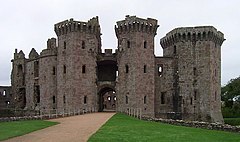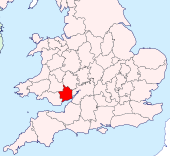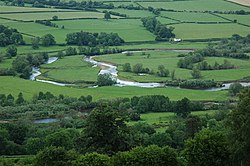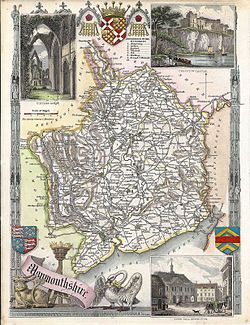Monmouthshire: Difference between revisions
No edit summary |
|||
| (56 intermediate revisions by 4 users not shown) | |||
| Line 2: | Line 2: | ||
|name=Monmouthshire | |name=Monmouthshire | ||
|welsh=Sir Fynwy | |welsh=Sir Fynwy | ||
|map image= | |map image=Monmouthshire Brit Isles Sect 5.svg | ||
|flag=Flag of Monmouthshire.svg | |||
|motto=Utrique Fidelis<br />(Faithful to both) | |||
|picture= Ragland castle t100.jpg | |picture= Ragland castle t100.jpg | ||
|picture caption= | |picture caption= Raglan Castle | ||
|county town=Monmouth | |county town=Monmouth | ||
|biggest town=[[Newport, Monmouthshire|Newport]] | |biggest town=[[Newport, Monmouthshire|Newport]] | ||
|flower=Foxglove | |||
}} | }} | ||
The '''County of Monmouth''' is a [[Counties of the United Kingdom|shire]] in the south-west of [[Great Britain]]. The eastern part of the county is mainly agricultural, while rich mineral resources were discovered in the western valleys in the 18th century. This led to the western part of the county becoming highly industrialised with coal mining and iron working becoming major employers between the 18th and late 20th centuries.<ref>{{cite web |url=http://www.visionofbritain.org.uk/place/place_page.jsp?p_id=17183 |title=Monmouthshire |accessdate=2008-08-24 |author=John Bartholomew |date=1887 |work=Gazetteer of the British Isles |publisher=Vision of Britain}}</ref> | |||
[[Monmouth]], the county town, stands at the extreme north-east of the county, on the border with [[Herefordshire]], while the largest settlement, the city of [[Newport, Monmouthshire|Newport]] lies in the southern coastal belt. The highest point is ''[[Chwarel y Fan]]'' at 2,228 feet. | |||
{{ | ==Geography== | ||
Monmouthshire lies to the north of the Severn Estuary, which forms the county's southern border. Three other rivers form the majority of the county's other borders: The Wye forms the eastern border with [[Gloucestershire]], the Rhymney forms the western border with [[Glamorgan]] and the Monnow forms the north-eastern border with [[Herefordshire]]. The [[Brecon Beacons]] form the northern border with [[Brecknockshire]]. | |||
The parish of [[Welsh Bicknor]] is an exclave of Monmouthshire, sandwiched between Gloucestershire and Herefordshire. The Herefordshire hamlet of [[Fwthog]] adjoining the [[River Honddu|Honddu Valley]] is an exclave within Monmouthshire. | |||
The island of [[Denny Island|Denny]] in the [[Bristol Channel]] also belongs to Monmouthshire and hundred of [[Caldicot Hundred|Caldicot]]. | |||
===Rivers=== | |||
[[File:The River Usk - geograph.org.uk - 1381189.jpg|thumb|250px|The Usk meandering near Scethrog]] | |||
Monmouthshire is watered by four main rivers, fed from the county's verdant valleys, of which three are border rivers and the fourth runs through the green heart of the shire. | |||
The [[River Monnow]] marks the border with [[Gloucestershire]], flowing out of the [[Black Mountains]], it runs 26 miles down to [[Monmouth]], which town takes its name from the river and thus so does the county of Monmouth itself. | |||
The [[Wye]] is one of the great rivers of the kingdom; indeed only four rivers of Britain are longer. It is not specifically a Monmouthshire river, rising in the mountains between [[Brecknockshire]] and [[Radnorshire]] and swelling in the womb of [[Herefordshire]], but its broad lower reach is Monmouthshire's eastern border, with [[Gloucestershire]], and on this river stand the fine Monmouthshire towns of Monmouth and Chepstow and the picturesque valley side at [[Tintern]]. | |||
The [[River Rhymney]] flows off the [[Brecon Beacons]], down the Rhymney Valley amongst the mining villages which once turned is waters black. Its highest village is [[Rhymney]] and its lowest [[Rumney]], and between these two namesakes and down to the [[Severn]] estuary its whole course marks the border between Monmouthshire and [[Glamorgan]]. | |||
The [[River Usk]] is the river which waters Monmouthshire's heartland. It sees all the contrasting aspects of the county in its course. It enters the shire as a young river in the mountains in the northernmost parts, above [[Abergavenny]], and meanders gently through the rolling farmland in middle of the shire, eventually coming to [[Caerleon]] of the county's historic heritage, and then on to the county's urban aspect, in the ancient and modern of [[Newport, Monmouthshire|Newport]], disgorging its waters into the Severn Estuary at [[Uskmouth]]. | |||
===Hundreds=== | |||
[[File:Monmouthshire Hundreds.jpg|thumb|250px|Map of the hundreds of Monmouthshire by Thomas Moule, c. 1831]] | |||
The county was divided into six [[Hundred]]s in 1542: ({{kmloutline|MonmouthshireHundredsA}}) | |||
*[[Abergavenny Hundred|Abergavenny]] | |||
*[[Caldicot Hundred|Caldicot]] | |||
*[[Raglan Hundred|Raglan]] | |||
*[[Skenfrith Hundred|Skenfrith]] | |||
*[[Usk Hundred|Usk]] | |||
*[[Wentloog Hundred|Wentloog]] | |||
===City=== | |||
[[File:Monmouthshire Flag at Devauden.jpg|thumb|250px|the Flag of Monmouthshire flying at the Hood Memorial Hall, Devauden]] | |||
*[[Newport, Monmouthshire|Newport]] | |||
===Towns=== | |||
{{div col|2}} | |||
*[[Abergavenny]] | |||
*[[Blackwood, Monmouthshire|Blackwood]] | |||
*[[Blaenavon]] | |||
*[[Caldicot, Monmouthshire|Caldicot]] | |||
*[[Chepstow]] ''(partly in [[Gloucestershire]])'' | |||
*[[Cwmbran]] | |||
*[[Ebbw Vale]] | |||
*[[Monmouth]] ''([[county town]])'' | |||
*[[Newbridge, Monmouthshire|Newbridge]] | |||
*[[New Tredegar]] ''(partly in [[Glamorgan]])'' | |||
*[[Pontypool]] | |||
*[[Rhymney]] ''(partly in [[Glamorgan]])'' | |||
*[[Risca]] | |||
*[[Tredegar]] | |||
*[[Usk]] | |||
{{div col end}} | |||
===Boundary towns=== | |||
The valley of the Rhymney River is extensively urbanised, such that many towns and other settlements straddle the border between Monmouthshire and [[Glamorgan]]: | |||
*[[Cardiff]] lies in the extreme south-east of Glamorgan, such that its eastern suburbs of Rumney and St Mellons lie across the Rhymney River in Monmouthshire. | |||
*[[Caerphilly]], also in Glamorgan, has its eastern suburb of [[Bedwas]] across the Rhymney River in Monmouthshire. | |||
*[[Maesycwmmer]] in Monmouthshire and Ystrad Mynach in Glamorgan form a single conurbation. | |||
*[[Blackwood, Monmouthshire|Blackwood]] in Monmouthshire has its western suburb of Tir-y-Berth across the Rhymney River in Glamorgan. Additionally, the suburb of Pengam has its railway station on the Glamorgan side. | |||
*[[Bargoed]] in Glamorgan and [[Aberbargoed]] in Monmouthshire form a single town under the Bargoed Town Council. Aberbargoed is located on the eastern side of the Rhymney river and in Monmouthshire, whereas Bargoed town and suburbs are located on the western side of the Rhymney river and therefore a part of Glamorgan. | |||
*[[New Tredegar]] has western suburbs of Brithdir and part of Tirphil across the Rhymney River in Glamorgan. The communities of Elliots Town and Phillipstown are on the eastern side of the river in Monmouthshire. | |||
*[[Rhymney]], located at the north of the Rhymney Valley, is the most north-westerly community. For civil purposes it includes Abertysswg, Butetown, Rhymney and Lechryd and extends into Glamorgan to the west and Brecknockshire to the north. | |||
Several settlements also straddle the river Wye, which forms the border between Monmouthshire and Gloucestershire: | |||
*[[Chepstow]] lies in the extreme south-east of Monmouthshire, such that its eastern suburbs of Sedbury and Tutshill are in Gloucestershire. | |||
*The village of [[Brockweir]] in Gloucestershire is situated on the eastern bank of the Wye such that the main access into the village is from the A466 in Monmouthshire. The former railway station on the Wye Valley line was also on the western (Monmouthshire) bank. | |||
*The village of [[Redbrook]] straddles the border where it heads away from the river in a north-easterly direction. | |||
Along the urbanised northern border with [[Brecknockshire]] is a further example of a cross-border conurbation: | |||
*The [[Rassau]]-[[Brynmawr]]-[[Beaufort]]-[[Nantyglo]]-[[Ebbw Vale]] area forms a single conurbation, with the former three lying in Brecknockshire and latter two part of the industrialised Monmouthshire western valleys. | |||
===Villages=== | |||
See [[:Category:Towns and villages in Monmouthshire]] | |||
===Parishes=== | |||
{{parishliststart}} | |||
* [[Abercarn]] | |||
* [[Abergavenny]] | |||
* [[Abersychan]] | |||
* [[Abertillery]] | |||
* [[Allt-yr-yn]] | |||
* [[Alway]] | |||
* [[Argoed, Monmouthshire|Argoed]] | |||
* [[Badminton, Monmouthshire|Badminton]] | |||
* [[Bedwas, Trethomas and Machen]] | |||
* [[Beechwood, Monmouthshire|Beechwood]] | |||
* [[Bettws, Monmouthshire|Bettws]] | |||
* [[Bishton]] | |||
* [[Blackwood, Monmouthshire|Blackwood]] | |||
* [[Blaenavon]] | |||
* [[Caerleon]] | |||
* [[Caerwent]] | |||
* [[Caldicot, Monmouthshire|Caldicot]] | |||
* [[Cefn Fforest]] | |||
* [[Chepstow]] | |||
* [[Coedkernew]] | |||
* [[Croesyceiliog]] | |||
* [[Crosskeys]] | |||
* [[Crucorney]] | |||
* [[Crumlin, Monmouthshire|Crumlin]] | |||
* [[Cwm, Monmouthshire|Cwm]] | |||
* [[Cwmbran|Cwmbran Central]] | |||
* [[Devauden]] | |||
* [[Ebbw Vale|Ebbw Vale North]] | |||
* [[Ebbw Vale|Ebbw Vale South]] | |||
* [[Fairwater]] | |||
* [[Gaer]] | |||
* [[Goetre Fawr]] | |||
* [[Goldcliff]] | |||
* [[Graig]] | |||
* [[Grosmont]] | |||
* [[Gwehelog Fawr]] | |||
* [[Henllys, Monmouthshire|Henllys]] | |||
* [[Langstone, Monmouthshire|Langstone]] | |||
* [[Liswerry]] | |||
* [[Llanarth, Monmouthshire|Llanarth]] | |||
* [[Llanbadoc]] | |||
* [[Llanfoist Fawr]] | |||
* [[Llangattock Vibon Avel]] | |||
* [[Llangwm, Monmouthshire|Llangwm]] | |||
* [[Llangibby]] | |||
* [[Llanhennock]] | |||
* [[Llanhilleth]] | |||
* [[Llanover]] | |||
* [[Llanrumney]] | |||
* [[Llantarnam]] | |||
* [[Llantilio Crossenny]] | |||
* [[Llantilio Pertholey]] | |||
* [[Llantrisant Fawr]] | |||
* [[Llanvaches]] | |||
* [[Llanwern]] | |||
* [[Llanyrafon]] | |||
* [[Maesycwmmer]] | |||
* [[Magor with Undy]] | |||
* [[Malpas, Monmouthshire|Malpas]] | |||
* [[Marshfield, Monmouthshire|Marshfield]] | |||
* [[Mathern]] | |||
* [[Michaelstone-y-Fedw]] | |||
* [[Mitchel Troy]] | |||
* [[Monmouth]] | |||
* [[Nantyglo and Blaina]] | |||
* [[Nash, Monmouthshire|Nash]] | |||
* [[Newbridge, Monmouthshire|Newbridge]] | |||
* [[New Inn, Monmouthshire|New Inn]] | |||
* [[New Tredegar]] | |||
* [[Old St Mellons]] | |||
* [[Panteg]] | |||
* [[Pengam]] | |||
* [[Penhow]] | |||
* [[Penmain|Penmaen]] | |||
* [[Pen Tranch]] | |||
* [[Pillgwenlly]] | |||
* [[Ponthir]] | |||
* [[Pontllanfraith]] | |||
* [[Pontnewydd]] | |||
* [[Pontymoile]] | |||
* [[Portskewett]] | |||
* [[Raglan]] | |||
* [[Redwick, Monmouthshire|Redwick]] | |||
* [[Rhymney]] | |||
* [[Ringland]] | |||
* [[Risca]] | |||
* [[Rogerstone]] | |||
* [[Rogiet]] | |||
* [[Rumney]] | |||
* [[Shaftesbury, Monmouthshire|Shaftesbury]] | |||
* [[Shirenewton]] | |||
* [[St Arvans]] | |||
* [[St Julians]] | |||
* [[Stow Hill]] | |||
* [[Tintern]] | |||
* [[Tredegar]] | |||
* [[Tredegar Park]] | |||
* [[Trellech United]] | |||
* [[Trevethin]] | |||
* [[Trowbridge, Monmouthshire|Trowbridge]] | |||
* [[Upper Cwmbran]] | |||
* [[Usk]] | |||
* [[Victoria]] | |||
* [[Wentlooge]] | |||
* [[Ynysddu]] | |||
{{parishlistend}} | |||
==Transport== | |||
Monmouthshire lies at the junction of major routes from South Wales to [[London]] and the Midlands. Major roads include the [[M4 motorway]] from London to Carmarthenshire, the parallel A40 and A48 routes and the A465 and A449 routes to the Midlands. | |||
Princiapal rail routes converge on Newport, including the South Wales Main Line via the [[Severn Tunnel]], the Gloucester to Newport Line, Welsh Marches Line and Ebbw Valley Line. | |||
The Monmouthshire canal and the Brecknockshire and Abergavenny canal converge at Pontymoile near [[Pontypool]]. | |||
==Things to see in Monmouthshire== | |||
{{UKPlacesKey|W}} | |||
[[File:Llanthony.priory.JPG|thumb|right|250px|Llanthony Priory]] | |||
===Castles=== | |||
{{i-Castle}} Castles: | |||
*[http://www.abergavennymuseum.co.uk/index.php?lang=EN;navId=3 Abergavenny Castle] | |||
*{{i-House}} [http://www.caldicotcastle.co.uk/ Caldicot Castle] | |||
*{{i-Cadw}} [http://www.cadw.wales.gov.uk/default.asp?id=245 Chepstow Castle] | |||
*{{i-Cadw}} [http://www.cadw.wales.gov.uk/default.asp?id=6&PlaceID=76 Grosmont Castle] | |||
*{{i-Cadw}} [http://www.cadw.wales.gov.uk/default.asp?id=6&PlaceID=36 Isca Silurum] (Isca Augusta), [[Caerleon]] | |||
*[http://www.castlewales.com/newportg.html Newport Castle] | |||
*{{i-Cadw}} [http://www.cadw.wales.gov.uk/default.asp?id=6&PlaceID=113 Raglan Castle], | |||
*{{i-NTE}} [http://www.nationaltrust.org.uk/main/w-skenfrithcastle Skenfrith Castle] | |||
*{{i-Cadw}} [http://www.cadw.wales.gov.uk/default.asp?id=258 Venta Silurum], [[Caerwent]] | |||
*{{i-Cadw}} [http://www.cadw.wales.gov.uk/default.asp?id=6&PlaceID=142 White Castle] | |||
===Other fine buildings and ruins=== | |||
*Blaenavon (mining heritage) | |||
*{{i-Abbey}} [[Llanthony Priory]] | |||
*[[Monmouthshire and Brecon Canal]]s | |||
*Fourteen Locks | |||
*{{i-Museum}} [http://www.museumwales.ac.uk/en/roman/ National Roman Legion Museum], [[Caerleon]] | |||
*{{i-Cathedral}} [[Newport Cathedral]] | |||
*[http://www.newport.gov.uk/_dc/index.cfm?fuseaction=museumheritage.museum Newport Museum], [[Newport, Monmouthshire|Newport]] | |||
*Roman Baths Museum, [[Caerleon]] | |||
*{{i-Abbey}} [[Tintern Abbey]] | |||
*{{i-House}}{{i-MuseumNotFree}} [[Tredegar House]] | |||
===Landscape and walks=== | |||
*[[Black Mountains]] | |||
*[[Brecon Beacons]] National Park | |||
*[[Caldicot and Wentloog Levels]] | |||
*[[Chwarel y Fan]] | |||
*{{i-NTE}} [[The Kymin]] | |||
*Marches Way | |||
*[[River Monnow|Monnow Valley]] Walk | |||
*[[Offa's Dyke Path]] | |||
*Pontypool Park | |||
*Three Castles Walk | |||
*[[River Usk|Usk Valley]] Walk | |||
*[[River Wye|Wye Valley]] | |||
==See also== | |||
*[[Flag of Monmouthshire]] | |||
==References== | |||
{{reflist}} | |||
==Outside links== | |||
*[http://monmouthshire-association.org.uk/ Monmouthshire Association] | |||
{{British county}} | {{British county}} | ||
Latest revision as of 12:02, 9 June 2023
| Monmouthshire Welsh: Sir Fynwy United Kingdom | |
 Raglan Castle | |
|---|---|

| |
| Flag | |
| Utrique Fidelis (Faithful to both) | |

| |
| [Interactive map] | |
| Area: | 542 square miles |
| Population: | 514,723 |
| County town: | Monmouth |
| Biggest town: | Newport |
| County flower: | Foxglove [1] |
The County of Monmouth is a shire in the south-west of Great Britain. The eastern part of the county is mainly agricultural, while rich mineral resources were discovered in the western valleys in the 18th century. This led to the western part of the county becoming highly industrialised with coal mining and iron working becoming major employers between the 18th and late 20th centuries.[1]
Monmouth, the county town, stands at the extreme north-east of the county, on the border with Herefordshire, while the largest settlement, the city of Newport lies in the southern coastal belt. The highest point is Chwarel y Fan at 2,228 feet.
Geography
Monmouthshire lies to the north of the Severn Estuary, which forms the county's southern border. Three other rivers form the majority of the county's other borders: The Wye forms the eastern border with Gloucestershire, the Rhymney forms the western border with Glamorgan and the Monnow forms the north-eastern border with Herefordshire. The Brecon Beacons form the northern border with Brecknockshire.
The parish of Welsh Bicknor is an exclave of Monmouthshire, sandwiched between Gloucestershire and Herefordshire. The Herefordshire hamlet of Fwthog adjoining the Honddu Valley is an exclave within Monmouthshire.
The island of Denny in the Bristol Channel also belongs to Monmouthshire and hundred of Caldicot.
Rivers

Monmouthshire is watered by four main rivers, fed from the county's verdant valleys, of which three are border rivers and the fourth runs through the green heart of the shire.
The River Monnow marks the border with Gloucestershire, flowing out of the Black Mountains, it runs 26 miles down to Monmouth, which town takes its name from the river and thus so does the county of Monmouth itself.
The Wye is one of the great rivers of the kingdom; indeed only four rivers of Britain are longer. It is not specifically a Monmouthshire river, rising in the mountains between Brecknockshire and Radnorshire and swelling in the womb of Herefordshire, but its broad lower reach is Monmouthshire's eastern border, with Gloucestershire, and on this river stand the fine Monmouthshire towns of Monmouth and Chepstow and the picturesque valley side at Tintern.
The River Rhymney flows off the Brecon Beacons, down the Rhymney Valley amongst the mining villages which once turned is waters black. Its highest village is Rhymney and its lowest Rumney, and between these two namesakes and down to the Severn estuary its whole course marks the border between Monmouthshire and Glamorgan.
The River Usk is the river which waters Monmouthshire's heartland. It sees all the contrasting aspects of the county in its course. It enters the shire as a young river in the mountains in the northernmost parts, above Abergavenny, and meanders gently through the rolling farmland in middle of the shire, eventually coming to Caerleon of the county's historic heritage, and then on to the county's urban aspect, in the ancient and modern of Newport, disgorging its waters into the Severn Estuary at Uskmouth.
Hundreds

The county was divided into six Hundreds in 1542: (map)
City

Towns
- Abergavenny
- Blackwood
- Blaenavon
- Caldicot
- Chepstow (partly in Gloucestershire)
- Cwmbran
- Ebbw Vale
- Monmouth (county town)
- Newbridge
- New Tredegar (partly in Glamorgan)
- Pontypool
- Rhymney (partly in Glamorgan)
- Risca
- Tredegar
- Usk
Boundary towns
The valley of the Rhymney River is extensively urbanised, such that many towns and other settlements straddle the border between Monmouthshire and Glamorgan:
- Cardiff lies in the extreme south-east of Glamorgan, such that its eastern suburbs of Rumney and St Mellons lie across the Rhymney River in Monmouthshire.
- Caerphilly, also in Glamorgan, has its eastern suburb of Bedwas across the Rhymney River in Monmouthshire.
- Maesycwmmer in Monmouthshire and Ystrad Mynach in Glamorgan form a single conurbation.
- Blackwood in Monmouthshire has its western suburb of Tir-y-Berth across the Rhymney River in Glamorgan. Additionally, the suburb of Pengam has its railway station on the Glamorgan side.
- Bargoed in Glamorgan and Aberbargoed in Monmouthshire form a single town under the Bargoed Town Council. Aberbargoed is located on the eastern side of the Rhymney river and in Monmouthshire, whereas Bargoed town and suburbs are located on the western side of the Rhymney river and therefore a part of Glamorgan.
- New Tredegar has western suburbs of Brithdir and part of Tirphil across the Rhymney River in Glamorgan. The communities of Elliots Town and Phillipstown are on the eastern side of the river in Monmouthshire.
- Rhymney, located at the north of the Rhymney Valley, is the most north-westerly community. For civil purposes it includes Abertysswg, Butetown, Rhymney and Lechryd and extends into Glamorgan to the west and Brecknockshire to the north.
Several settlements also straddle the river Wye, which forms the border between Monmouthshire and Gloucestershire:
- Chepstow lies in the extreme south-east of Monmouthshire, such that its eastern suburbs of Sedbury and Tutshill are in Gloucestershire.
- The village of Brockweir in Gloucestershire is situated on the eastern bank of the Wye such that the main access into the village is from the A466 in Monmouthshire. The former railway station on the Wye Valley line was also on the western (Monmouthshire) bank.
- The village of Redbrook straddles the border where it heads away from the river in a north-easterly direction.
Along the urbanised northern border with Brecknockshire is a further example of a cross-border conurbation:
- The Rassau-Brynmawr-Beaufort-Nantyglo-Ebbw Vale area forms a single conurbation, with the former three lying in Brecknockshire and latter two part of the industrialised Monmouthshire western valleys.
Villages
See Category:Towns and villages in Monmouthshire
Parishes
- Abercarn
- Abergavenny
- Abersychan
- Abertillery
- Allt-yr-yn
- Alway
- Argoed
- Badminton
- Bedwas, Trethomas and Machen
- Beechwood
- Bettws
- Bishton
- Blackwood
- Blaenavon
- Caerleon
- Caerwent
- Caldicot
- Cefn Fforest
- Chepstow
- Coedkernew
- Croesyceiliog
- Crosskeys
- Crucorney
- Crumlin
- Cwm
- Cwmbran Central
- Devauden
- Ebbw Vale North
- Ebbw Vale South
- Fairwater
- Gaer
- Goetre Fawr
- Goldcliff
- Graig
- Grosmont
- Gwehelog Fawr
- Henllys
- Langstone
- Liswerry
- Llanarth
- Llanbadoc
- Llanfoist Fawr
- Llangattock Vibon Avel
- Llangwm
- Llangibby
- Llanhennock
- Llanhilleth
- Llanover
- Llanrumney
- Llantarnam
- Llantilio Crossenny
- Llantilio Pertholey
- Llantrisant Fawr
- Llanvaches
- Llanwern
- Llanyrafon
- Maesycwmmer
- Magor with Undy
- Malpas
- Marshfield
- Mathern
- Michaelstone-y-Fedw
- Mitchel Troy
- Monmouth
- Nantyglo and Blaina
- Nash
- Newbridge
- New Inn
- New Tredegar
- Old St Mellons
- Panteg
- Pengam
- Penhow
- Penmaen
- Pen Tranch
- Pillgwenlly
- Ponthir
- Pontllanfraith
- Pontnewydd
- Pontymoile
- Portskewett
- Raglan
- Redwick
- Rhymney
- Ringland
- Risca
- Rogerstone
- Rogiet
- Rumney
- Shaftesbury
- Shirenewton
- St Arvans
- St Julians
- Stow Hill
- Tintern
- Tredegar
- Tredegar Park
- Trellech United
- Trevethin
- Trowbridge
- Upper Cwmbran
- Usk
- Victoria
- Wentlooge
- Ynysddu
Transport
Monmouthshire lies at the junction of major routes from South Wales to London and the Midlands. Major roads include the M4 motorway from London to Carmarthenshire, the parallel A40 and A48 routes and the A465 and A449 routes to the Midlands.
Princiapal rail routes converge on Newport, including the South Wales Main Line via the Severn Tunnel, the Gloucester to Newport Line, Welsh Marches Line and Ebbw Valley Line.
The Monmouthshire canal and the Brecknockshire and Abergavenny canal converge at Pontymoile near Pontypool.
Things to see in Monmouthshire
| Key | |
| Cathedral/Abbey/Priory | |
| Accessible open space | |
| Amusement/Theme Park | |
| Castle | |
| Country Park | |
| Cadw | |
| Forestry Commission | |
| Heritage railway | |
| Historic House | |
| Museum (free/not free) | |
| National Trust | |
| Zoo | |

Castles
- Abergavenny Castle
 Caldicot Castle
Caldicot Castle Chepstow Castle
Chepstow Castle Grosmont Castle
Grosmont Castle Isca Silurum (Isca Augusta), Caerleon
Isca Silurum (Isca Augusta), Caerleon- Newport Castle
 Raglan Castle,
Raglan Castle, Skenfrith Castle
Skenfrith Castle Venta Silurum, Caerwent
Venta Silurum, Caerwent White Castle
White Castle
Other fine buildings and ruins
- Blaenavon (mining heritage)
 Llanthony Priory
Llanthony Priory- Monmouthshire and Brecon Canals
- Fourteen Locks
 National Roman Legion Museum, Caerleon
National Roman Legion Museum, Caerleon Newport Cathedral
Newport Cathedral- Newport Museum, Newport
- Roman Baths Museum, Caerleon
 Tintern Abbey
Tintern Abbey
 Tredegar House
Tredegar House
Landscape and walks
- Black Mountains
- Brecon Beacons National Park
- Caldicot and Wentloog Levels
- Chwarel y Fan
 The Kymin
The Kymin- Marches Way
- Monnow Valley Walk
- Offa's Dyke Path
- Pontypool Park
- Three Castles Walk
- Usk Valley Walk
- Wye Valley
See also
References
- ↑ John Bartholomew (1887). "Monmouthshire". Gazetteer of the British Isles. Vision of Britain. http://www.visionofbritain.org.uk/place/place_page.jsp?p_id=17183. Retrieved 2008-08-24.
Outside links
| Counties of the United Kingdom |
|---|
|
Aberdeen • Anglesey • Angus • Antrim • Argyll • Armagh • Ayr • Banff • Bedford • Berks • Berwick • Brecknock • Buckingham • Bute • Caernarfon • Caithness • Cambridge • Cardigan • Carmarthen • Chester • Clackmannan • Cornwall • Cromarty • Cumberland • Denbigh • Derby • Devon • Dorset • Down • Dumfries • Dunbarton • Durham • East Lothian • Essex • Fermanagh • Fife • Flint • Glamorgan • Gloucester • Hants • Hereford • Hertford • Huntingdon • Inverness • Kent • Kincardine • Kinross • Kirkcudbright • Lanark • Lancaster • Leicester • Lincoln • Londonderry • Merioneth • Middlesex • Midlothian • Monmouth • Montgomery • Moray • Nairn • Norfolk • Northampton • Northumberland • Nottingham • Orkney • Oxford • Peebles • Pembroke • Perth • Radnor • Renfrew • Ross • Roxburgh • Rutland • Selkirk • Shetland • Salop • Somerset • Stafford • Stirling • Suffolk • Surrey • Sussex • Sutherland • Tyrone • Warwick • West Lothian • Westmorland • Wigtown • Wilts • Worcester • York |